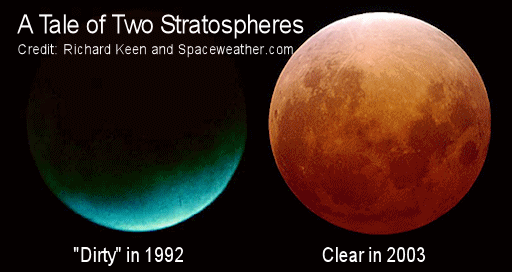Hi Tom. Right, you're talking about the Gleissberg cycle. I was just using recent examples of times of similar levels of solar activity that had different amounts of dust in the stratosphere, due to the eruption of Pinatubo in the earlier time period and a lack of major volcanic activity in the second time period.
What I'm trying to say is yes, solar activity would effect how long volcanic dust remains aloft in the stratosphere and also affects volcanic activity, with an emphasis on the transition periods. The stratosphere, where volcanic dust grains tend to hang out, is not ionized/conductive so the charged grains are immersed in an insulating medium. In the case of weak solar activity corresponding to weak discharge activity between the ionosphere and ground (TLE's: sprites, blue jets, et al.) the dust grains would tend to lose their charge slowly and remain suspended longer in a stratified layer (the stratosphere in this case) in the electric field between the ionosphere and ground. In the case of vigorous TLE's, the charged grains would lose their charge more rapidly and so remain suspended for less time.
It seems counterintuitive in a way. Stronger solar activity producing stronger ionospheric discharge would tend to clear the atmosphere by dissipating the charge in dust grains, while weaker solar activity would tend to allow more charged dust to retain their charge and remain suspended longer.
The transitions are an important factor as well, discussed in this paper on the Gleissberg cycle:
The Solar WOLF-GLEISSBERG Cycle and it's Influence on the Earth
It is the purpose of the present work, first to review and establish strong connections between Solar
(80-100) yr. Wolf-Gleissberg cycles, and various climatic criteria, as manifested both in contemporary
time series as well as periodicities. Secondly to review known climatic fluctuations and to show that
they are coincident with Wolf-Gleissberg cycles turning points and thus are stimulated by Solar
forcing possibly arising from magnetic changes in and in-between those cycles with the capacity of
backward and foreword forecast of various climatic fluctuations as manifested by droughts, abrupt rise
or fall of lakes or closed sea levels as well as global cooling or warming
Bold emphasis mine to highlight the importance in the rate of change of the magnetic field, which I've been emphasizing, regardless of which stage solar activity is at in relation to either long or short term cycles.
Krakatoa is a prime example, which is famous for the sulfur dioxide that remained suspended in the atmosphere, yet it occurred in 1883, during the last minimum in the Wolf-Gleissberg cycle. It also occurred right after a solar minimum, at the beginning of the transition to a new max in the 11 year cycle. 1883 also falls within the years of transition from W-G cycle min ramping up to the 1958 max as indicated in Table 1 of the paper linked above.
Not trying to argue with ya there Tom 'cause I agree that solar activity effects the amount, and longevity, of dust in the atmosphere, it just seems that including all the pieces of the puzzle, as I see it anyways, has brought me to a different conclusion in how that relates to long and short term solar cycles.

cheers

